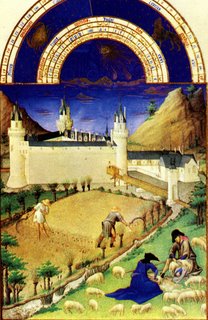
(click on image to enlarge)
The Limbourgs represent here the rustic activities of the month of July, the harvest and sheep shearing, in the vicinity of the Château du Clain in Poitiers. Poitiers was, in fact, one of the Duc de Berry's habitual homes, a part of his appanage like Berry and Auvergne.Two peasants reap, not with scythes as in the haymaking, but with sickles. One, closely resembling a harvester in the month of June, wears a straw hat and a simple shirt under which appear his drawers or petits draps as they were then called. Every detail of the wheat is minutely rendered. The heads are more golden than the stalks and both are speckled with flowers; on the ground lies the mown wheat, not yet bound in sheaves but already drier than the rest.At lower right a man and woman proceed with the sheep shearing. Each holding an animal on one knee, they cut the wool with a kind of shears called forces; the shorn wool accumulates at their feet.This miniature is a precious document of a château that no longer exists. The Duke had reconstructed the triangular building thirty or forty years hefore.This view is from the right hank of the Clain. A wooden footbridge leads to the right tower, resting on three stonework piers that still stand in the riverbed; at one end a moveable bridge leads to a rectangular entrance tower, and at the other a drawbridge is attached to the château.We glimpse a chapel to the right of the château amid buildings separated from it by an arm of the river. The towers are constructed in the style favored by the Duke and evident in his various châteaus: corbelled with machicolations and crenatures, and decorated in the interior courtyard with high windows.In the background the artists have painted conventionally shaped mountains, the asymmetrical cones often found in their works.
It is a shame that pretty chateau is no longer standing. But the country side is still awfully pretty. The above is all lifted from http://www.christusrex.org/www2/berry/berry1.html
As the tourism brochure for Pontiers says....
PoitiersLes chemins de Notre-Dame. Au fil du chemin Rouge Amateurs de nature et de grands espaces, cette visite vous conduira jusqu'au parc de Blossac dessiné au XVIIIè siècle sur les remparts de la ville. Le jardin anglais ajouté au XIXe siècle et Grand Pré complètent cet îlot de verdure. Vous admirerez aussi, dans le quartier Saint-Hilaire, le Doyenné -où a vécu Geoffroy d’Estissac, le protecteur de Rabelais- et l'imposante église Saint-Hilaire, construite sur le tombeau du saint et décorée de peintures murales au Moyen Age. Au retour, vous passerez devant les vestiges des arènes romaines et vous pourrez entrer dans la chapelle Saint-Louis du collège Henri IV. Elle possède un somptueux retable incrusté de marqueterie en marbre, ivoire et ébène. La sacristie, également du XVIIe siècle, présente un bel ensemble de portraits d’évangélistes.
4 comments:
nice painting. coming from "sheep people" myself, I can vouch we never sheared sheep in such a pastoral setting. Ours was more of a "roll in the dust, smell like sheep, and lather up in the lanolin" type of scene.
grin!
Where do you learn this stuff?!
Now Jennifer, I don't know this stuff. I find this information on the internet. These are not my words, but rather, the web site.
http://www.christusrex.org/www2/berry/berry1.html
I have credited them on this posting.
I DO however have a deep and abiding interest in medieval castles, arms, armour and weaponry. And a reasonably good memory on where to find this information.
Post a Comment